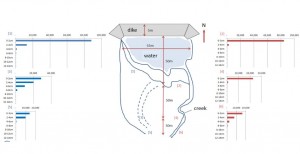Radiocesium in reservoirs
By Ichio Ii
Reservoir decontamination
There are concerns that a high level of radiocesium (Cs134, Cs137) might accumulate at the bottom of water reservoirs, if so, the crops cultivated using the reservoir water could be contaminated with a high level of radiocesium. To respond to these concerns, the national government has decided to support the local government with subsidies and technologies to conduct decontamination work
Survey of reservoirs
The residents who are residing now and the evacuees who are thinking to return home in the future are desperately concerned with the water for drinking and agriculture. On the other hand, some study result says, most of radiocesium detected in the reservoir water is in the state of “suspension”, that means, the cesium has strongly bound to clay particles that are suspended in the water. Therefore the transfer of radiocesium to crops is very limited. Another opinion says, the effectiveness of the decontamination of reservoirs would be somewhat limited because contaminants would enter the reservoir again after decontamination.
Measurement of the reservoir mud in Tamano district
As the first step to understand the situation at the bottom of reservoirs, “Resurrection of Fukushima” measured a distribution of radiocesium level of the soil at a dried reservoir bottom.
Obara-san, a member volunteer of the NPO, took the samples of the reservoir bottom at six locations in Tamano on February 12, 2014. Then “Circle Madei”, a volunteer group from the Faculty of Agriculture of Tokyo University carved each sample in 2 cm thickness, which was individually packed in a vial on May 12, 2014. And had the radioactivity measured using the NaI scintillation counter at RI Center of the Faculty on May 28, in cooperation with Assistant Professor A. Hirose.
The following chart illustrates the distribution of radioactivity (dry weight base) in 0-14 cm deep at each point.
The locations [1] and [2] were the state in which the soil still kept some moisture just after water has dried up, so these samples seemed to maintain the condition as that in the reservoir bottom under water.
The other four points are the locations wherein it took some time after the reservoir bottom was dried out.
Observations by Ichio Ii
- Recently dried reservoir bottoms ([1] and [2]) contain higher level of radiocesium than the early dried bottoms ([5] and [6]). The recently dried bottom concentrates radiocesium in a much shallower depth (0-2 cm from the surface), than the early dried bottom.
By extrapolating from this result, it is estimated that at the part where water still remains at the reservoir bottom, radiocesium concentrates in a much thinner surface and the level is over 100,000 Bq/kg of dry soil. - If decontamination work of reservoir bottom is considered, draining water and scraping of the bottom surface by 2cm deep can reduce cesium level by more than 90%. But it is also likely that the drained water is entrained with contaminated sediments. And contamination may happen again if contaminated fallen leaves and soil on the mountains flow into the reservoir. We need to consider decontamination from a holistic perspective, including decontamination of forests.
